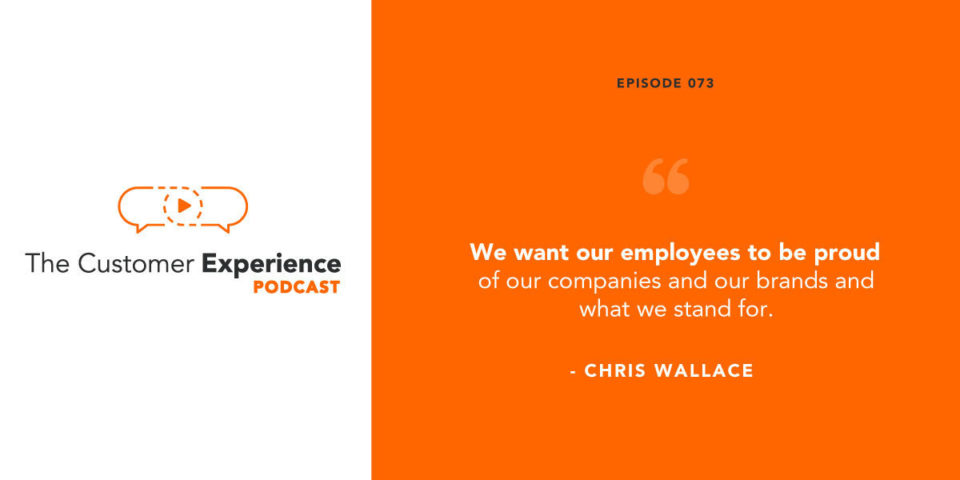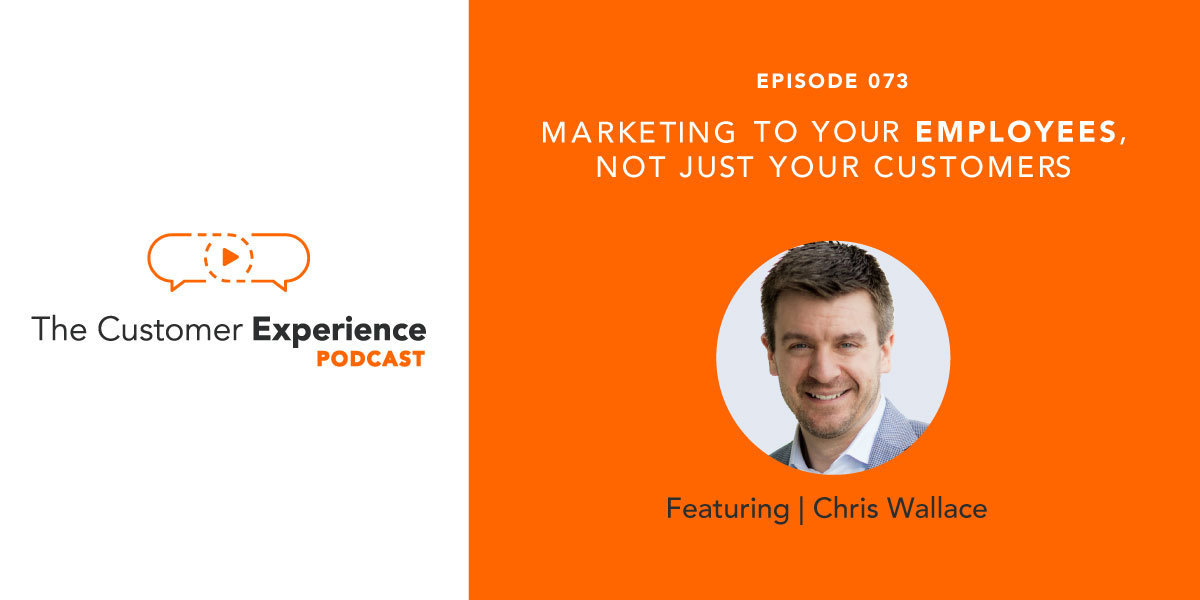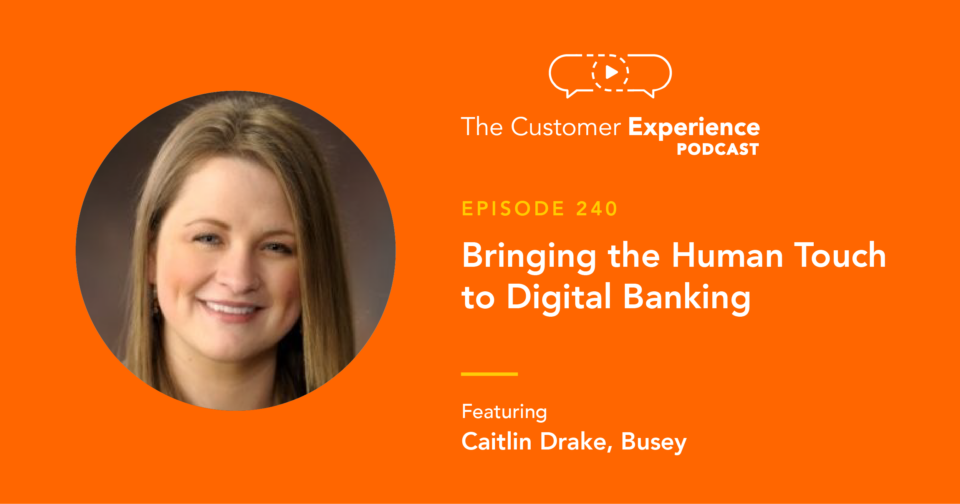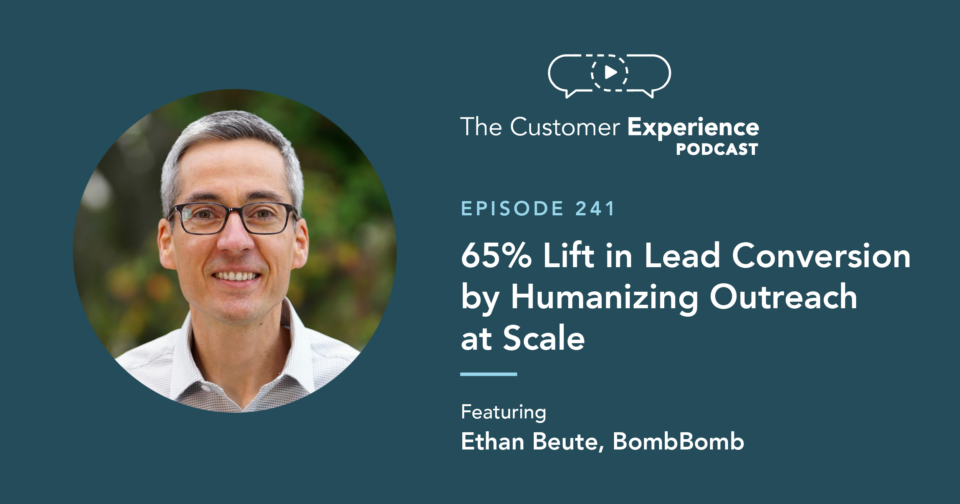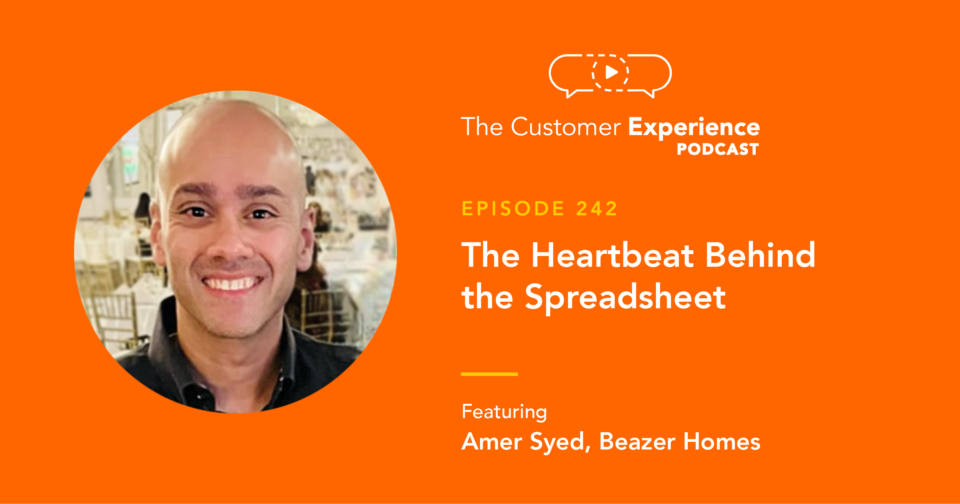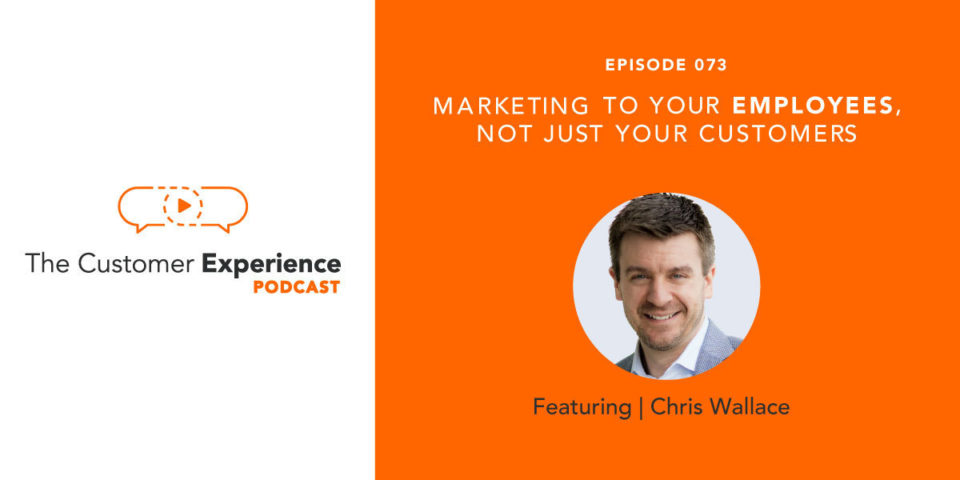
Listen to “73. Marketing To Your Employees, Not Just Your Customers w/ Chris Wallace” on Spreaker.
Apple Podcasts | Google Podcasts | Stitcher | Spotify
Think of all the time, effort, and money that our companies spend on marketing our products and services to potential and current customers. A lot, right? But it’s all in vain if your customer experience doesn’t live up to expectations.
Because ultimately, as we market our brands, we’re marketing promises to our consumers. And CX is measured by how we deliver on these commitments.
So, how do we ensure that our brand promise matches our delivered experience? One way to close the gap is by marketing to our employees, too.
They are the ones facing customers every day – giving them the customer experience your business depends on for success. So, we need to put in the work to make sure our employees understand, believe in, and live out the brand they are hired to represent.
This episode of The Customer Experience Podcast focuses on brand consistency and internal marketing.
Our guest, Christopher Wallace, specializes in helping companies align their brand and product stories with their customer-facing teams. He turns customer experience inside out by equating customer experience with the employee experience.
Christopher is the Cofounder and President at InnerView Group, a firm that helps companies engage their frontline teams to improve the customer experience and boost revenue performance.
Throughout our conversation, you’ll learn more about the unique relationship between brand and customer experience… and how that relates to employees. We discuss…
• Why customer experience is a brand differentiator
• Where the common disconnect lies between brand and CX
• How to avoid brand dilution by closing the gap between your brand promise and customer experience
• How to infuse your team with a sense of pride and purpose in their work and in your company
• Why internal marketing is essential to the employee experience
Marketing To Employees, Not Just Customers
Hear the entire conversation with Christopher Wallace on focusing on internal marketing right here:
Listen to “73. Marketing To Your Employees, Not Just Your Customers w/ Chris Wallace” on Spreaker.
Want a more traditional podcast experience? Check out The Customer Experience Podcast in …
Please take a minute to subscribe to, rate, and review the podcast. It’s very helpful!
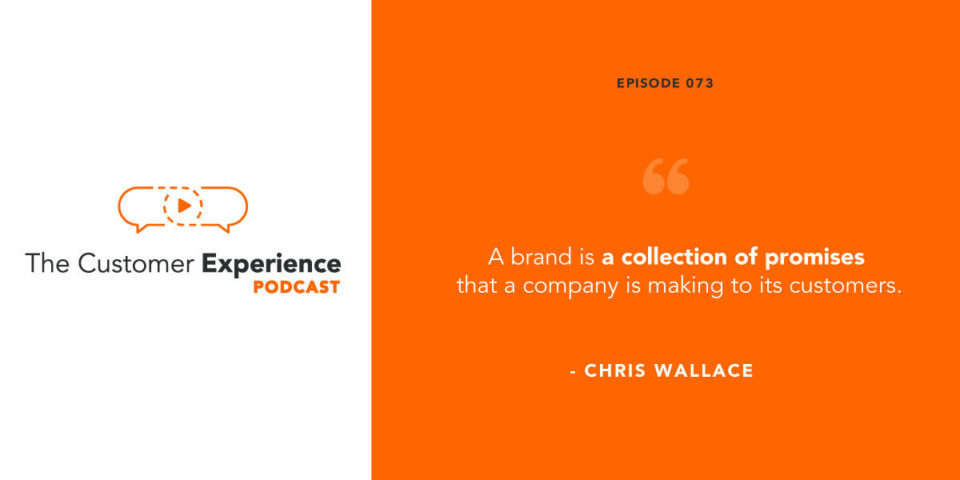
Full Transcript: Marketing To Your Employees, Not Just Your Customers
Ethan Beute:
Our company spends so much time, energy and money marketing our products and services to our customers and our potential customers, but what about our employees? Our guest is here today to talk about internal marketing and brand consistency. To this conversation, he brings 20 years of sales, marketing, and corporate leadership experience at companies like Comcast, Insight Sales, and the PGA. Today, he’s co-founder and president at InnerView Group, a firm that helps companies engage their frontline teams to improve customer experience and ultimately to boost revenue performance. Christopher Wallace, welcome to The Customer Experience Podcast.
Christopher Wallace:
Ethan, thank you so much for having me. I think that’s the best intro I’ve ever gotten, so great job with that.
Ethan Beute:
Awesome. Thank you. Small point of pride for me, and I want you to feel welcome and for people to know how beneficial this is going to be based on your experience. But before we get going, in earnest, I’m in Colorado Springs, you are in the Philadelphia area. What’s the current situation with regard to the Coronavirus pandemic? How’s it affecting you or your team or your customers?
Christopher Wallace:
Yeah. Well, we could probably spend the entire time on just that. We, fortunately, had been used to working remotely over the years. We do have our headquarters here in Philadelphia, which is where most of our staff is, but we do have people sprinkled all over the country. We were all armed with our Zoom accounts prior to this happening. I think from our customers’ perspective it really is … it really depends. It’s company to company, because one of our major customers is the country’s largest internet service provider and they’re slammed right now. They’re one of the most important companies in the country right now and it’s putting all sorts of different strain on them from a capacity perspective than it is on other companies may be in the manufacturing or the banking space. It’s really kind of industry to industry right now.
Ethan Beute:
Interesting. Yeah, it’s the same for us. We have a number of people who are coming to us. Our current lead flow is just through the roof because we make it easy to stay face to face with people through simple videos and emails. Like you, we were primarily in office together in Colorado Springs. We’re about 150 people, and most of us are in the office physically, but we have enough people up in Denver and in other cities around the country that we’re all equipped to work remotely and do meetings remotely and all of that. The transition of the work itself hasn’t been too challenging yet, although it’s … who knows? It depends how long it persists as well.
Christopher Wallace:
Yeah. I think the only X factor for us is for the people on our team, like myself, who have children, school-aged children that we’re trying to manage through some of the homeschool stuff right now, some of the remote learning. That’s a challenge because a workday’s not exactly a work day anymore, but we’re managing. We’ve got it a lot better than a lot of people do, so we’re happy to keep on chugging. My team has been great. We’re talking daily, doing our Zoom calls, so we’re making it work for right now.
Ethan Beute:
I love it. Gratitude is the way. Let’s get going, and we’ll start where we always start, which is your thoughts or definition around customer experience. When I say customer experience, what does it mean to you, Christopher?
Christopher Wallace:
Well, so I’m going to start by saying that one of the things that, when we built InnerView, we had been in the professional services business before and had some … I had a lot of experience in consulting. When we started it, we were very intentional with how we started the company. One of those things was this idea of the vision for the company. We talked about, with the vision of our company, is to take something that seems intangible and turn it into something that can be deposited in the bank. That’s part of our vision for our company. I think it translates really well into my definition of customer experience because I think of customer experience as the currency for the new generation.
Christopher Wallace:
It used to be products and features or kind of some of your more traditional, is the product better than the competition? Yes or no? There are so many companies, there are so many options, there are so many ways to get goods and services that the products are, in this product parody, service parody, just about in every single category. I really do look at the experience as the great differentiator from brand to brand. I guess my definition really is the added value that an organization is building into their interactions with customers that separate them above and beyond their products and services.
Ethan Beute:
I like it. I like the value anchor and I like that it is in the interactions. That is where the experience is most felt, I think. Really good calling. You’re absolutely right. It’s a primary thesis on the show here, is that hyper-competition which you described in product parody, render customer experience as the ultimate differentiator. What a cool thing to be able to start a company with that perspective and to make decisions through that lens. We’re going to be going, I feel like a little bit back and forth between employee experience and brand branding, brand experience, brand consistency, brand dilution. I just wanted to tee up that I’m really excited about this one because both of them are truly inside out. One of my early mentors around branding really made it clear that it needs to be lived from the inside before it can be felt outside, and that’s the way that you make it consistent.
Ethan Beute:
I love this connection to the employee. Then, I don’t know if you’re familiar with the service profit chain, which is … it’s available for anyone to read a digest version at Harvard Business Review.
Christopher Wallace:
It’s a Harvard business book, right?
Ethan Beute:
Yeah, correct.
Christopher Wallace:
Yeah. It was an article then they made a book.
Ethan Beute:
Yeah. When I was learning about your company in anticipation of this, I was just really excited because I feel like that’s a significant, intentionally or not, perfectly consistent with that, which is the idea that the revenue and the profitability are the outcomes. Customers are the midpoint, but really spending so much more time and energy building that internal service quality and making sure that the employee experience is fantastic is the necessary precursor to all of it. I guess we’ll start here, which is the reason I always ask about customer experiences that you get a variety of answers, although there are some singing, some consistent themes. I feel like the same thing is true of branding. I’d love for you to talk about brand and brand experience relative to customer experience. In your view, in your opinion, are they synonymous? Are there differences? How do you think about that?
Christopher Wallace:
Yeah. I don’t know that I would say that they’re synonymous, but I think that they’re sort of tied to one another. The way we always talk about brand is a brand is a collection of promises that accompanies making to its customers. That’s the way we think of it. We think of it as the brand really comes down to the essence of a company. Then essence is, why do we exist? What are we saying we can do for customers? Why do we have a place in this world? We always come back to, we look at the brand as the promises that are being made. We look at the customer experience as whether or not the promises are being kept. That’s how we see the two of those things being linked. It’s really important that you look at them in tandem. We’ve found both through research and through practical work that they’re disconnected far too much of the time.
Ethan Beute:
What do you think the primary cause is? Is that one of them is overlooked or one of them is undervalued? Where’s the disconnect, do you think?
Christopher Wallace:
I believe the disconnect. I’m in the process of writing a research. We did some research and we’re in the process of writing the research report right now. But from that research, what we’ve been able to see is, in the organizations that we support, and we’re typically working with either a business to consumer, a brand, or a consumer brand that goes to market through B2B2C. Maybe they have distributors or retail partners. Think of a consumer electronics brand. They go to market, B2B2C, but they’re typically consumer brands. Typically, what we’re seeing is the people who are designing the brand and the architects of that brand story, the people who make the promise and the people who keep the promise or who are responsible for keeping the promise, the physical and mental distance between those two departments is probably wider than we even thought.
Christopher Wallace:
Let me give you an example. The research that we just did, which hasn’t been released yet, but I’ll share some of the findings, one of the things we found was in asking customer-facing employees and consumer industries, retail, airlines, hospitality, restaurants, your typical consumer and consumer industries, who do they see as most critical in helping them sort of deliver the customer experience and tell that brand story? How do they know what brand promises they need to keep? Where do they get that from? Where do they get that direction from? We gave them six different groups within their organization that they could choose from. Marketing ranked fifth out of six. The physical and mental distance between somebody who works at a register and the person that that does the ad buys is huge.
Christopher Wallace:
It’s even bigger than we thought it was, to be honest. We knew it was big, but we’re seeing, the data tells us that it’s wider than we even thought. To me, that’s a big challenge. The people who are spending the money on the advertising and spending the money to build the campaigns, if they are not linked, if they do not have a strong bond with the people delivering that customer experience, you were bound to have a breakdown between promise and delivery. That’s what so many brands have, is that breakdown between promise and delivery. I’m going to come down to, they simply just don’t see each other. When I say they, the customer-facing teams and the marketing and brand department in most organizations just don’t see each other as one another stakeholders enough of the time.
Ethan Beute:
Would you say that that’s one of the biggest points of value in engagement when you engage with a company as InnerView? Is that one of the disconnects that’s probably one of the bigger points that you’re working on? Or what’s the scope of engagement?
Christopher Wallace:
Yeah, that’s really what it is. A lot of it comes down to, and that didn’t say that was the rift simply because it dovetails in with what we do. Because again, we’re seeing from the data that’s even bigger than we thought, but we really do build a bridge between that strategic vision of where the brand wants to go and the day to day execution. Think of it this way. If a campaign is done, you go to your agency, you reposition yourself, you’re going after a new demographic you’ve got great creative, you’ve got great ads, you have a great ad buy, and you go out with that campaign and the demand starts flowing, the phones ring, the foot traffic picks up, all those things, but the people who actually service those customers are disconnected. Think about how much of a drag on the results of that campaign and uninformed and uninspired frontline employee group can be.
Christopher Wallace:
Think about how big that disconnect … We’ve filled that gap, we’ve closed that gap for companies. Again, it ends up being much bigger than even we thought it would be going in.
Ethan Beute:
Really interesting. It tees up where I wanted to go next, which is your thoughts on the relationship between the employee experience and the customer experience.
Christopher Wallace:
Yeah. I won’t call it controversial, but maybe a little bit provocative view of the employee experience to customer experience. The way we look at the link between the two is we believe very strongly that employee … I would bet you’d get more definitions of employee experience than you would of customer experience because people really look at that in very different ways. The way we look at it is you have people who are hired to do a job. If we can put them in a position to believe in the brand that they represent and be in a position to serve that customer to the best of their ability if they are good at their job every single day, if they are serving customers well and they are getting that positive feedback from customers, whether it’s just in body language and exchange or in good-natured interaction, or if it’s coming through literal feedback through customer surveys and things like that, we believe the pride in what they do is going to grow.
Christopher Wallace:
We believe very strongly in let’s put them in a position to serve the customers the best they possibly can. In doing so, you’re going to build their pride in working for the brand that they represent, and their pride generally in serving customers. We look at it as, help them serve their customers, help them do their job to the best of their ability and their satisfaction with the work that they do and their engagement is going to go way up. A lot of other organizations look at it as, which is very feasible and viable, is this idea of let’s make happy employees and happy employees make happy customers. It’s a lot of like employee experience becomes making sure that they’ve got great coffee machines in their break rooms or there’s snacks or there’s a lot of truly workplace empowerment type programs.
Christopher Wallace:
Those are all well and good, but we cut straight to the chase and we say put them in a position to serve the customers better, get them more excited about the products and the brand that they represent and watch their satisfaction as an employee goes through the roof.
Ethan Beute:
So there is a positive upward spiral. It reminds me of this idea that a company culture is not a foosball table or beer on tap.
Christopher Wallace:
A lot of companies think that.
Ethan Beute:
Right. But to your point, I love that you cut straight to it. What does that look like in practice? Is this more internal training? What are a couple tangible, actionable things around like how do we get employee buy-in? Especially maybe for a company that’s been operating, let’s say for years, they’ve taken a lot of this for granted, and now you have the culture, what is normal, what is accepted, what’s been tolerated, what it feels like to show up every day is a certain way. How do you start, from a practical standpoint, start transitioning that to get that buy-in and that belief like winning the hearts and minds of the employees so that the customers can feel it?
Christopher Wallace:
It’s a great question. What you just asked, the line we always use is, people, when you start talking about these types of things, marketers typically say, we have this challenge, but fixing it just feels so daunting. The reality is, why it feels so daunting, it’s because they look at their employees, they separate their employees as one group and their customers as another group. Marketers are in the business of mass behavior change. That’s what they do. Their job is to compel people to act in new ways based on a message that they’ve heard or some sort of stimulus. We look at it as it’s not that hard and not that daunting. If you take the things that you’re so good at right now and you just apply them to the employee group, just as if they were a buyer.
Christopher Wallace:
The biggest aha here is to look at them as a buyer and consumer of your message, not as a messenger, just for a minute. If you can get them to buy it first and really believe in it, then getting them to be a messenger is a lot easier. Organizations go the other way around. They try to make people messengers of something that they don’t necessarily believe in. What we do is, just like any good marketing campaign, we start with market research. We developed a tool called the brand transfer study and the brand transfer score. What we are quite literally doing is we are assessing an organization’s message, sort of their core brand message. What are the key pillars of that message? We’re assessing the corporate architects of that message and then all the people out in the field or wherever else inside the organization that represents that message.
Christopher Wallace:
We’re coming back to an organization with a point of view just like you would with a customer, just as you would come back with market research and say, here’s what the customers think of you, here’s how the customers view you. They don’t think you’re good at this. They think your competition’s kicking your butt here, but they think you’re strong here. We’re doing the same thing with the internal audience and we’re coming back to a marketer saying, you believe your brand story is this, but you’re losing 27%. You’re misaligned by 27% with your retail team, or you’re misaligned 17% with your channel partners or your distribution partners. We’re coming back to them with research, market research. It just so happens we’re doing market research on a different audience.
Christopher Wallace:
But once you have that data in hand, again, what do marketers do with data? You build a messaging campaign and you drive tactics out in different mediums out that are going to move the needle. The key here is, you have to think far outside, hitting send out an email or posting a product training, to really get people’s attention and to compel them to change their behavior. You wouldn’t try to train a customer to be excited about your brand, but that’s how organizations … Again, they’re trying to make them messengers, the people represent the brand, messengers before they’re believers, we want to flip the script for them. The internal campaigns that we run, they look more like the type of campaign you’d run to consumers than they do something that you’re typically doing through your training department.
Ethan Beute:
I love it. What team is this coming out of? Do you engage marketing departments to do the work or do you provide it as a third party?
Christopher Wallace:
We work with the marketing department, so we are typically partnering with, it could be anybody from the brand and core marketing team inside of brand. It could also be a channel leader, somebody that’s responsible for channel marketing, for a dealer channel or for a call center channel, or whatever the case may be. It’s typically the marketing. The way it goes is marketing typically says, man, wouldn’t it be nice if I could get my people on message. Because that’s our question to a marketer. How confident are you that your people are on message? And they’re not so confident. We say, okay, great. You think you might have this challenge, then we become partners with the people, like the sales leadership, the training team. We become the glue that sort of holds those things together.
Christopher Wallace:
To your question earlier about working with the customer-facing teams and the marketing team, we become that bridge. We become the conduit between the marketers that just don’t have the internal mechanisms to link up with those people down at the front lines and we build that bridge for them and help manage it over time.
Ethan Beute:
Love it. How much of this is branding work? You say on-message, and on-message could mean, why are we all here, why do we show up, who do we serve and what do we solve for them at a high level? Or it could be like you offered before, maybe a new campaign or a new product or a new service that maybe the frontline is ignorant of, or just plain misunderstands. How much are you talking brand in this scenario?
Christopher Wallace:
It’s a really good question. This I will say. We don’t build your brand. We always joke, we’re like VASF we don’t build your brand. We’re execution people. I think that what we’ve done is we’ve tried to break it down into six, what I’m going to call triggers that drive the work that we do. There’s product and service launches. As a marketing team, we’re bringing something new to market. We have a new thing that we want to get out there. Our customers need it. We’ve done all the research. We’ve got to get it to market. The story we’re telling there is, your frontline teams, whether you like it or not, they’re gatekeepers. You need them to be offering this. You need them to be recognizing the customer’s need in order for this new product or service to be successful. You’ve got to open up those flood gates early and not wait until you’re 30% to your goal to figure out how to engage those folks.
Christopher Wallace:
Typically, most brands cannot drive enough demand to their doorstep to make every product and service launch worthwhile. You’ve got to get your frontline team engaged. Campaigns and promotions. It’s coming up on your big selling season. You’re making a big push, you’ve got some promotional pricing, you’ve got a key pricing promotion out there in the marketplace. You really want to get traction for it. You need to get your team bought in. It’s another trigger. Getting into some of the more philosophical ones around brand, company rebranding, and mergers and acquisitions. The common theme here is, anytime change is coming to your brand, anytime you’re pivoting, anytime you’re swiveling with your brand and you’re adding something and bringing a new message out to the marketplace, that’s typically where we get involved.
Christopher Wallace:
But rebrands are a big one in mergers and acquisitions. How do you bring two brands into one? How do you get people, as one of our clients says, “act the brand”? I love that idea of how do you act the brand? In a rebrand or a merger and acquisition scenario, that’s such a key piece.
Ethan Beute:
Yeah. It just begs it.
Christopher Wallace:
It’s critical, especially with big companies, you find that banks merge and people don’t know how to talk about who they are on day one any more than they did the day before. It causes a lot of customer confusion. The last two are customer experience programs. If companies are investing in their customer experience, how do we make sure that their brand truly is built into that program and it’s launched in a way that’s going to drive that excitement, and frankly, it’s going to make it stick at the frontlines? Finally, it’s really dealer and channel support. You’ve got these programs that you need to push out to call it a non-employee base. These are people who don’t have to do it because it’s on their scorecard or they’re bonused on it. It’s people that you have to really influence into driving the actions that you want. Those are really the six triggers. T
Ethan Beute:
hat’s great. I like the framework and that last step there. In a lot of cases, depending on the nature of the partnership, the customer doesn’t know or care whether they’re direct employees or not. Functionally, they are. They are brand representatives whether you want them to be or not. It’s obviously important to to rope them in and make sure that they understand everything the same way as a direct employee would. Let’s talk for a minute about brand dilution. What are the costs there? How do we get more consistent? How does it happen? Just talk about some of the dynamics there.
Christopher Wallace:
Yeah. Brand dilution is quite simply the difference between what the brand is promising and what the customer hears. When you talk about the definition of brand and the definition of customer experience, we look at brand dilution as the gap between those two things, how wide is that gap? The research that we’ve done with senior level marketers and customer experience executives, what we found was it was really interesting. The people who felt like their organization was poor at getting that message out in an aligned way, they perceived that the diluted message had, at a cost, still significant. Right about half of the respondents that we had valued that gap at $5 million, between five and 10 million annually, or excuse me, north of 5 million annually.
Christopher Wallace:
But for the organizations that felt like they were good at it, we asked them to ascribe a value to that consistent message. 62% of those people, now these were with larger organizations, but 62% of those people put a price tag of $10 million plus on the value of having that consistent message. When I say the value, we’re not talking about … this isn’t paper value. We’re talking about in the transactions day to day, in the interactions that we talked about earlier, we are winning more business because our people can represent our brand more consistently. Our brand can stand out, our brand has value, and the more we live our brand and act the brand, the more business we’re going to win. That’s what that dollar value is telling us, is the brands who do this well, 62% said they would put a value of more than $10 million annually on that attribute of their organization.
Christopher Wallace:
The perceived costs are high enough, but the actual value the companies are realizing actually is greater than the perceived cost of companies that are struggling.
Ethan Beute:
Obviously, so important just to the business functioning in general, I was thinking there about mid-level management, I would guess that you’re engaged by probably executives or senior leadership at some level. But really, where this is going to be made is probably at the mid level management scenario who they’re hiring, they are daily managing, they’re hopefully doing consistent one-on-one meetings and a variety of things there. I feel like that’s probably, when I think about the channels available for internal marketing to employees to keep them engaged, to help make some transformation the way they think about or even behave within the business. But that’s got to be one of the most important gateways.
Christopher Wallace:
It’s the most important gateway. That’s across all the work that we’ve done, all the consulting we’ve done over the years. I don’t care if you’re talking about sales and marketing or accounting. Frontline managers are the single most important group inside most, especially large organizations. They’re the leverage point. There were big initiatives and execution, either lives or dies. We’ve seen that across a whole bunch of different engagements that we’ve done over the years. Everything we do, all the engagements that we do, we try to account for the leadership in a really unique way. We try to make sure we can reach that leader on their terms. Just as we’re trying to equip the frontline employee to be a believer in the message so they can be a good messenger, we also have to do the same thing. This is a big waterfall. The message has to cascade down, and man, if it gets down to the frontline leader and stops there, you’ve got a real challenge. But most organizations, most big organizations especially, are only as good as their frontline leadership team.
Ethan Beute:
Yeah. I see here this opportunity to probably run into some resistance. One bad manager could probably ruin it for entire department or team. If they are either speaking out of both sides of their mouth or they just never get behind the message in the first place. What are some cautions? Obviously what was baked into your last response there is the idea that this needs to work for the company. It needs to work for the team and it needs to work for the individual, and we need to create that alignment. I mean that is part of the cascade. It needs to work at all levels and be clear at all levels. In terms of overcoming resistance and some of the other things that you run into in any change management or transformation process, do you have a couple of cautions for folks?
Christopher Wallace:
Yeah. I’m going to highlight one example. I have a really tangible example of what you just described. We have a client who’s a national home improvement brand. We did a brand transfer study with them recently. We did a readout with their national sales leader and we found something really interesting. They’re about to roll out a new customer experience initiative, so they’re completely overhauling the way they engage a customer, from the way the sales process to the in-home experience. It’s completely changing. What we found was senior leadership was very keenly aware of what needed to change. The frontline teams were very keenly aware of what needed to change, and the frontline leaders made it very clear that they were not interested in anything changing. If you think about it, it’s very logical and actually our client predicted that would happen.
Christopher Wallace:
The reason he predicted that was he said, if you think about frontline leaders, frontline leaders were promoted to where they are today because they worked well in the current system. If you introduce variables that take them outside of what help them get promoted to this point, they learn how to work in the current system to stand out and be successful. If you introduce new variables, you’ve just disrupted their world, you’ve upset their apple cart so to speak. The pitfall is you create training, and this is just one thing I want to stress. I have no problem with training. I think the training is needed. The challenge is the way it’s applied and the way it’s layered in in organizations, it’s typically marketing has a new product, we want people to sell it, we create product trainings, they take it online or it’s instructor led or they get a one sheet, whatever the case may be.
Christopher Wallace:
But in most cases, that frontline leadership team is left out of that, or they take the same one that their team did and they just glide, I don’t need to take this. They just click through it. The reality is, there’s a whole separate effort that needs to be focused on them and spoken to them in their language. It’s a separate part of the messaging campaign. You need to hit those frontline leaders and account for them differently than their frontline teams.
Ethan Beute:
So good. I see the very obvious parallels that you opened up on between tactics that you would use to market externally and tactics that you would use to market internally. You’ve got to meet people where they are and show them their unique benefit and value in the situation. I want to change gears briefly. I love my closing questions and I’m looking forward to your answers there, but you earned an MBA from the Fox School of Business and Management at Temple, and you’ve taught there as an adjunct professor. Just speak for a minute about any thoughts that occur to you about that? What’s the value of a higher ed in your opinion? Or what are some positive trends you’re seeing in customer experience at that level? Anything you have to share about that?
Christopher Wallace:
Yeah, I think I can share one pretty direct insight, and the class that I taught at Temple, it was leading in complex organizations. It was sort of a core class for the professional MBA program, which was the part time professional MBA students working adults. Everything we’re talking about all traces back to fundamentally sound leadership. I don’t care if you’re talking about customer experience or marketing, or sales, or the concepts all trace back to the same place. It goes in conjunction with the previous question about, how do you avoid some of those pitfalls? Well, it’s easy to say good leadership can avoid a lot of these pitfalls. It’s not good marketing leadership or good sales leadership, it’s just good leadership.
Christopher Wallace:
One of the ways that we found it, and probably the best way to tie it back in with the lessons that I taught at Temple, is this idea of there’s no better way to change behavior. There’s no better way to move people than to move laterally, not top-down. The top-down organization is fundamentally poor 21st leadership methodology. It’s just doesn’t work. We’re working in matrixed organizations. You’re working with an employee base that’s more empowered than they ever have been or at least they were before a couple of weeks ago. But the organization that can, that can drive change in a matrixed influence-based way are the ones that are going to be more nimble, more responsive, and are going to have smaller gaps in execution, the dilution that we talked about.
Christopher Wallace:
Dilution is just another way of saying gap and execution. I would say that’s one thing that, in reference to my experience through higher education, is a lot of the challenges that we face right now as marketers and otherwise, really comes back to just fundamentally sound, not just leadership, but 21st century leadership.
Ethan Beute:
Really good. The matrix piece is the key to moving forward. It’s interesting to think about how many businesses are still operating in a very traditional top-down manner. I would assume that you would agree with my speculation that they’re going to struggle to recruit and retain the best people.
Christopher Wallace:
Not only that. We work with a lot of companies that are more traditional, the older school type of industries like manufacturing businesses and things like that. One of the things that we found is people always do the blame the millennials game. Oh, well, it’s the millennials. They’re forcing the hand on this. I always say, millennials, all they did was they made it okay to want the things that all employees want. They just weren’t willing to take no for an answer. They wanted to be treated with respect. They believed in a pat on the back is worth as much as a bonus in your paycheck, and in some cases, it’s worth even more. I had a gentleman in his late 60s, a sales rep one time stand up and say, “I’ve got a couple of years left doing this and I’m going to go out the right way. The stuff you’re talking about, this is the way I want to lead. This is the way I want to be as a professional. I’m getting on board.”
Christopher Wallace:
People are fundamentally the same, whether they’re millennials or boomers. I just give credit to millennials for kicking through the door and saying we’re not going to compromise on things that matter to us as individuals.
Ethan Beute:
Really, really good. I appreciate that so much. We’ve had a couple of millennial conversations on here on the show and they typically point back to what you just shared there, which is they’re just regular people too, and they’re just changing some of the norms today, which is fantastic. If folks are listening and you enjoyed this conversation, you might also enjoy episode 39 with Lance and Levi from Dutch Bros Coffee. That one is about company culture as your competitive edge. One of my earlier conversations with my longtime friend, Kurt Bartolich on episode eight, take care of your brand and it will take care of you. He’s all about brand conservancy and protecting what’s good about it.
Ethan Beute:
Christopher, before I let you go, I’d like to know two things from you. First is someone who is … actually more than two things, but I’d love to give you the chance to thank or mention someone who’s had a positive impact on your life or your career.
Christopher Wallace:
Yeah, I appreciate the opportunity to do that. I’m going to take a moment and recognize somebody who has become a really dear friend and mentor to myself and my business partners. His name is Dr. Frank Cespedes. Dr. Cespedes is a senior lecturer at Harvard Business School. I want to say it was 2014, he released a book called Aligning Strategy and Sales. We read the article in HBR that was hyping up the book and we bought the book right away, a week after it had come out. I sent Dr. Cespedes an email at 9:30 one night, and by 10:30, I had an email back from him saying, “I’d love to talk to you.” “Sure, be happy to find some time.” Here we are almost six full years later and Dr. Cespedes has helped lead us into … we merged a prior practice with another firm that he had some contacts with.
Christopher Wallace:
He has helped us build the thesis and really see through the beginning of InnerView as we’ve taken what we knew from the past and started up again. But just very generous with his time and truly a testament to Harvard Business School and the horsepower that they have with their faculty there, it’s unbelievable.
Ethan Beute:
Fantastic story. I really appreciate that so much. I think so many of us who are consuming ideas and information, whether it’s through podcasts or videos or books or articles or whatever, are so hesitant, I think, to reach out to people. Even when I make my email address available on every conversation I have, when I’m in your seat, and it’s so funny how infrequently anyone takes advantage of it. Just like millennials are our employees with just different norms, these people are just doing their own work. They love their work. They’re proud of their work, I would assume in most cases, just like we want our employees to be proud of our companies and our brands and what we stand for. So many people are willing to engage, but that’s just above and beyond. I love it. How about a company that you really respect for the way they deliver for you as a customer?
Christopher Wallace:
I always use examples, when I’m doing sessions with clients, I always talk about the Nordstrom effect. I talk about, and I know that’s one of the ones that comes up frequently. I don’t want to be unoriginal, but I look at Nordstrom and say, the exercise that I do is … I’ll have a group of employees or leaders in a room and I’ll say, “Okay, who has ever shopped at Nordstrom?” Okay, three quarters of the room hands go up. “Who has ever left a Nordstrom and spent less money than they anticipated?” No hands go up. You always spend more. “Who has ever left a Nordstrom unsatisfied?” No hands go up. What that illustrates to me is, a brand … People don’t need to apologize for delivering products and services that meet the needs and wants of their customers.
Christopher Wallace:
So many times, frontline employees, this is where I talk about the idea of belief. People at Nordstrom really believe that they’re doing you a service. They believe that they’re helping you. They believe that finding you that right suit and right shirt for that job interview or for that client meeting, they really believe they’re serving you, not selling you. That belief is so critical. So many organizations have people that really rob the customer and the company of a larger transaction, a more fruitful relationship, so to speak, because they’re not willing to go that extra mile. The people at Nordstrom do and they deliver for their customers. People don’t walk away and feel like they were sold. They walk away and feel like they were helped. I’ll call out Nordstrom as a brand that really seems to do this well.
Ethan Beute:
Good one. The idea of the belief held and shared by each employee that they are doing something of real value, and it gives a sense of purpose and it gives you that sense of pride that you’ve been talking about throughout the conversation. That’s a great example to end on. Christopher, someone wants to follow up with you, they want to learn more about InnerView. Where would you send people?
Christopher Wallace:
Yeah, so you mentioned, given the personal email, I’d encourage anybody to reach out to me directly. I am cwallace@innerviewgroup. Now, it’s Inner, as in looking inside, looking at your inner self, I-N-N-E-R-V-I-E-W, not like a job interview, but it’s innerviewgroup.com. Then another great place to find me is LinkedIn, Chris Wallace at InnerView Group in the Philadelphia area. I have to caution people, I have a very common name. It’s not a rare name, so if you are looking for me, look for InnerView group and look in Philadelphia, you’ll find me.
Ethan Beute:
Awesome. I have found you there. I’m pleased to be connected. I appreciate your time so much. Really appreciate what you’re doing with InnerView. It’s obviously critically important and I think it’s … the more people that you serve, the more satisfied and joyful employees I think we’ll have.
Christopher Wallace:
Well, I appreciate the opportunity, Ethan. It’s been a great conversation.
Ethan Beute:
Cool. Thanks so much.
Christopher Wallace:
Of course.
Video Highlights: Marketing To Employees, Not Just Customers
Check out the top five video highlights from the discussion with Christopher below…
1. CX as a Brand Differentiator
2. Brand vs Customer Experience
3. The Big Gap Between Brand Promise and CX
4. Instilling Pride and Purpose Within Your Team
5. The Importance of Marketing To Employees
Other CX Conversations You’ll Enjoy:
- “Take Care Of Your Brand And It Will Take Care Of You” with Kurt Bartolich (Founder, Brand Certain)
- “Company Culture As Your Competitive Edge” with Lance Risser (VP of Southwest Field Operations, Dutch Bros Coffee) and Levi Ayriss (VP of Northwest Field Operations, Dutch Bros Coffee)
- “Differentiating Your Brand by Humanizing The Experience” with Ed Breault (CMO, Aprimo)
Please Subscribe to and Rate The Customer Experience Podcast:
